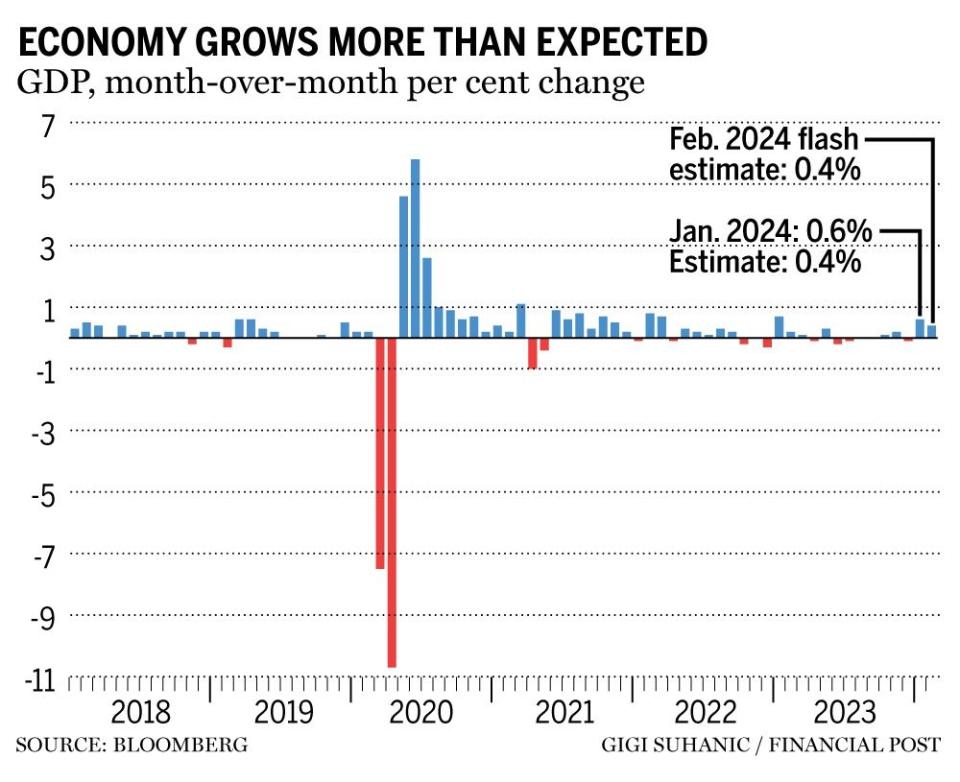Economy grows more than expected, keeping the Bank of Canada 'on its toes'

The Canadian economy surprised to the upside in January, posting its strongest monthly growth in a year, which could keep the Bank of Canada “on its toes,” say economists.
Real gross domestic product (GDP), which measures the value of goods and services produced during a specific time frame, edged up by 0.6 per cent in January, according to Statistics Canada, beating analysts’ expectations of 0.4 per cent. The agency also expects a 0.4 per cent rise in GDP during February.
“To put that two-month flurry of growth into perspective, the combined one per cent gain is as much as the economy grew in the entire 12 months of 2023,” Bank of Montreal chief economist Douglas Porter said in a note. “After a prolonged lull through much of last year … the economy looks to have caught some strong tailwinds early this year.”

The rise in GDP was due to broad-based growth in 18 of the 20 sectors measured by Statistics Canada.
The public sector, which includes education, health care and social assistance and public administration, increased 1.9 per cent in January, following two consecutive monthly declines. Education, which grew by six per cent, was the largest contributor to the country’s growth as activity rebounded from strikes by public sector workers in Quebec late last year.
Manufacturing fully recouped December’s decline in growth with a 0.9 per cent rise in January. A sudden drop in temperature in mid-January in parts of Canada contributed to increased activity in the utilities sector, which rose by 3.2 per cent, its highest growth rate since January 2022.
The real estate and rental sector grew for a third consecutive month — by 0.4 per cent — on higher resale activity. The Greater Toronto Area, Hamilton-Burlington and most markets in Ontario’s Greater Golden Horseshoe contributed to the growth.
The information and cultural services sector, which includes the motion picture and sound recording industry, also grew for the third consecutive month, as activity continued to ramp up following the end of a strike by the Screen Actors Guild – American Federation of Television and Radio Artists in November.
These “robust” figures could pose a difficult challenge for the Bank of Canada, Toronto-Dominion Bank economist Marc Ercolao said in a note.
While the central bank has received “solid evidence” in the past two months that inflation is cooperating, “strong GDP data prints” such as today’s will “keep them on their toes,” said Ercolao, who expects the first interest rate cut to take place in July.
On the labour front, Statistics Canada said there were 632,100 job vacancies in January, down 34,800, or 5.2 per cent, from November. Vacancies in the manufacturing sector declined by 10.2 per cent to 37,500, the lowest level since September 2017.
Monthly payroll increases were recorded in 13 of 20 sectors, led by retail trade, manufacturing and finance. But these gains were offset by a 0.3 per cent decline in construction.
The number of employees receiving pay and benefits from their employers, as measured by payroll employment, rose for the first time in the retail trade after four consecutive monthly declines.
Despite the strong start to the year, some economists expressed caution, especially regarding February’s GDP estimate.
Claire Fan, an economist at the Royal Bank of Canada, said the “substantially stronger-than-expected” numbers are partially driven by one-off factors such as the ending of the Quebec teachers’ strike, so growth isn’t likely to be sustained in the coming months.
“We’ve learned to take the advance estimates (February) with a grain of salt as they have been highly revision prone,” she said, while retaining RBC’s assessment of a weak economic backdrop.
BMO’s Porter said Canada experienced something similar last year when GDP stalled after a strong start to the year.
“There could be a serious issue with seasonality here, especially in light of much milder winters recently,” he said.
Despite the increase in GDP, most economists have stuck to their previous predictions that June will be when the Bank of Canada issues its initial interest rate cut.
• Email: nkarim@postmedia.com
Bookmark our website and support our journalism: Don’t miss the business news you need to know — add financialpost.com to your bookmarks and sign up for our newsletters here.
